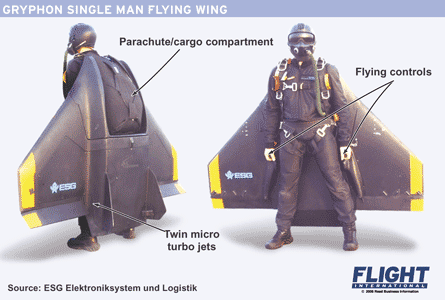A parachute system equipped with a 1.5m (4.9ft)-span delta wing and two micro-turbojets which could propel a paratrooper 200km (110nm) from a drop point could be tested from third-quarter 2007.
The wing has aileron- and flap-like control surfaces along its trailing edge, and around 2 litres (0.5USgal) of jet fuel housed in flexible containers in its leading edge. The surfaces would be controlled by the parachutist using handles linked to servomechanisms.

The engines are likely to be built into the wing, which also has a cargo compartment. The turbojets are expected to weigh around 7kg (15.4lb) each and could be model aircraft engines, industrial impellers or a new design. The wing system will weigh approximately 30kg with engines but no cargo.
“We have a lot of interest from special forces. Jumping from 4,000m [13,000ft] with the propelled system you could fly for 200km,” says civilian skydiving instructor and wing-parachute system test pilot Frank Carreras.
A parachutist could jump from up to 33,000ft using the system, with oxygen equipment and thermal clothing. On reaching an altitude of 3,000-5,000ft, the parachute is opened and the wing lowered on a cord to hang several metres below the user.
Carreras has been working for the parachute system’s developers, German electronics and technology companies ESG and Dräger, which originally developed an unpowered version for the German army. Flight testing of this 14kg system is expected to finish by year-end, after which the prototype will be used for marketing. With the unpowered system a soldier could glide for 50km from a 33,000ft jump.
Click here to see Jet Man video
Source: Flight International




















